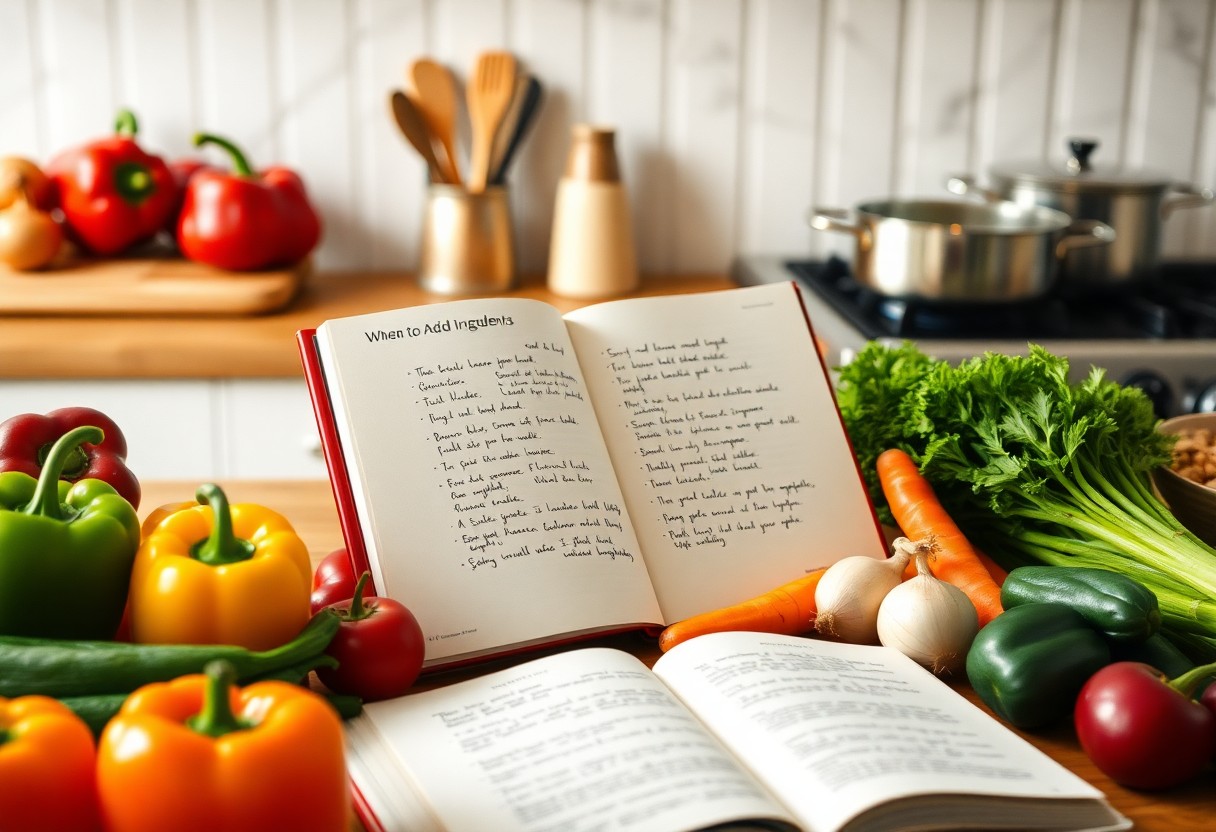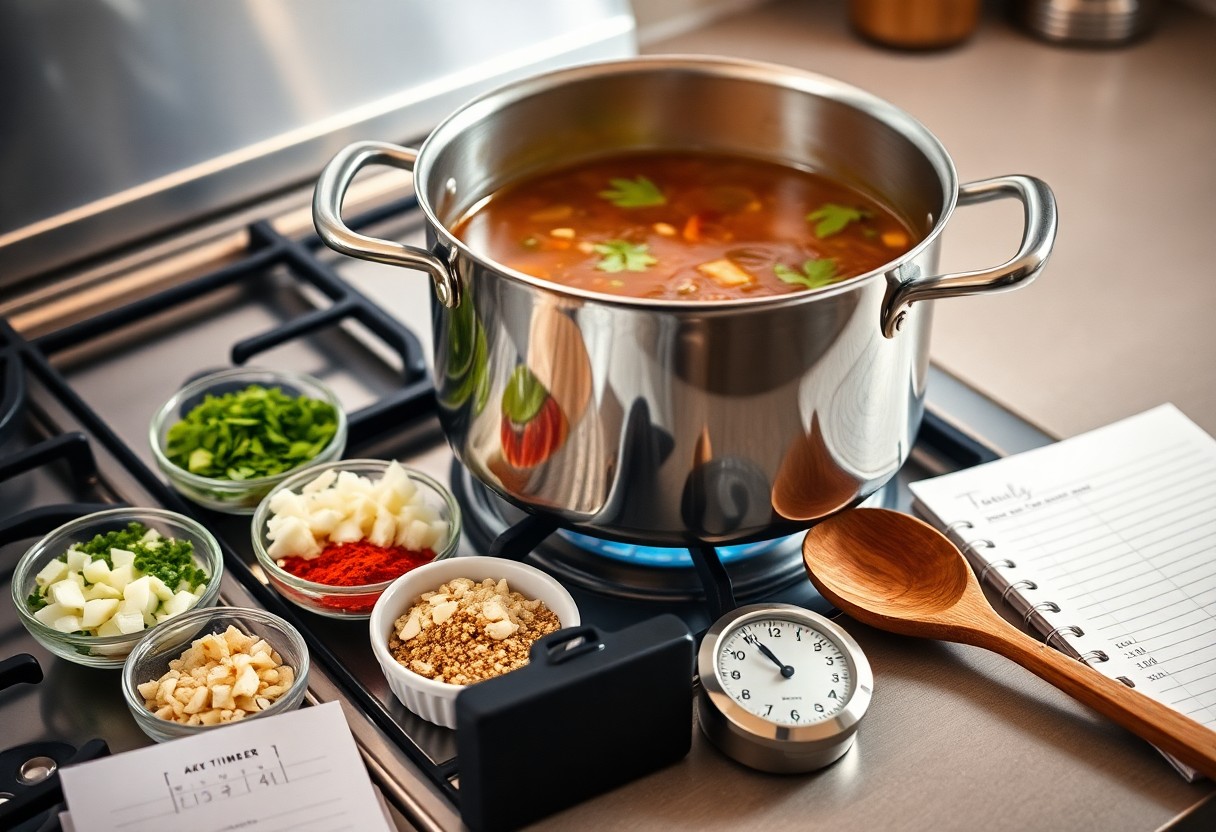There’s a fine line between a perfectly cooked dish and a culinary disaster, and that line often comes down to timing. Understanding when to add each ingredient can elevate your cooking from ordinary to extraordinary. From infusing flavors by starting with aromatics to ensuring vegetables retain their crunch, mastering the timing can enhance textures and develop depth in your meals. Join us as we explore how you can refine your skills and confidently decide the right moment for each component in your recipe.
Key Takeaways:
- Layering ingredients in the correct order enhances flavors and textures, ensuring even cooking and balance in the dish.
- Understanding the cooking times of different ingredients is necessary for achieving the desired doneness and preventing overcooking.
- Acidic components, herbs, and final seasoning should be added towards the end of the cooking process to preserve their brightness and freshness.
Understanding Cooking Techniques
Mastering various cooking techniques is vital for enhancing your timing when adding ingredients. Each method has its unique characteristics and influences the final texture and flavor of your dish. Recognizing how to best utilize these techniques can significantly improve your culinary skills, allowing you to make more informed decisions about when to introduce each ingredient for optimal results.
Sautéing and Stir-Frying
Sautéing and stir-frying are quick, high-heat methods that require you to add ingredients in a specific order. Start with aromatics like onions or garlic, then follow with harder vegetables that take longer to cook. Keep in mind that the ideal temperature is around 375°F to ensure you achieve that delicious, slightly caramelized finish without burning.
Baking and Roasting
Baking and roasting involve more than simply setting the oven temperature. Timing is vital; you should always preheat your oven to the designated temperature before placing your dish inside, as this helps create an even cooking environment. Ingredients like proteins and vegetables benefit from being seasoned and arranged properly, allowing for even heat distribution and maximizing flavor.
Roasting usually occurs at higher temperatures, around 400°F to 450°F, producing a delightful caramelization on the surface while ensuring inside moisture. Understanding the size and density of your ingredients is key; for instance, chunkier vegetables require longer cooking times than smaller pieces. Adding herbs or delicate ingredients near the end prevents them from losing their flavor and aroma during the cooking process.
Timing with Aromatics
Aromatics are vital in cooking, impacting flavor development and overall dish quality. Proper timing ensures that each ingredient releases its vital oils and flavors effectively. By understanding when to introduce each component, you elevate your dishes from bland to extraordinary. Timing can significantly alter the aroma and depth of your meals, which is why it’s critical to master the art of aromatic timings.
Onions and Garlic
Onions and garlic form the backbone of many cuisines, but the timing of their addition can make a noticeable difference. While onions should be sautéed until translucent for maximum sweetness, garlic needs to be added towards the end of the cooking process to prevent bitterness. This ensures a rich base flavor without overpowering the dish with raw, harsh notes.
Spices and Herbs
The timing of spices and herbs dictates their flavor release, which is vital to achieving a well-balanced dish. Dried spices benefit from early cooking, allowing them to bloom and integrate, while fresh herbs should be added at the end to maintain their vibrant flavor. For instance, adding cumin seeds at the start enhances the base, while basil sprinkled just before serving enlivens the dish with freshness.
Dried spices, like cumin or coriander, release their vital oils when heated, which enhances their flavors significantly within the first few minutes of cooking. Conversely, waiting until the last moment to add fresh herbs like parsley or cilantro preserves their bright, aromatic qualities, which fade during the cooking process. Adjusting the timing of these ingredients not only impacts flavor but can also affect the dish’s overall appearance and aroma, creating a multi-sensory experience. Mastering this timing transforms your cooking from routine to exceptional, resulting in dishes that resonate with depth and sophistication.
Cooking Proteins to Perfection
Achieving the perfect texture and flavor in proteins requires not just skill but also precise timing. Each type of protein has its optimal cooking duration and temperature, which can make or break your dish. Whether you’re searing steak or poaching chicken, knowing when to add your proteins to the heat is imperative for unlocking their full potential.
Meat and Poultry
When cooking meat and poultry, the timing significantly influences flavor and texture. For tender cuts like chicken breasts, cooking on medium heat for about 6-8 minutes per side yields juicy results. In contrast, tougher cuts such as brisket benefit from low and slow cooking, requiring several hours to break down connective tissues and enhance tenderness.
Fish and Seafood
Fish and seafood require attentive timing to avoid overcooking. Delicate fish fillets usually need just 3-4 minutes per side on high heat, while shellfish, like shrimp, cook rapidly in only 2-3 minutes. This precision helps maintain flavors and textures that are often lost with prolonged cooking.
For seafood, freshness determines cooking success. Knowledge of the type of fish or shellfish you’re preparing guides you in timing; for example, thicker fillets of salmon can be seared skin-side down for a crispy texture while remaining moist inside. Utilizing the *poke test*-where you gently press the fish to see if it flakes-can indicate doneness. The internal temperature for most fish should reach 145°F, ensuring safety without sacrificing quality. Your goal should always be to achieve a balance between cooking through and retaining the natural flavors and moisture inherent to seafood.

Vegetables: When to Add
Timing the addition of vegetables can dramatically impact your dish’s flavor and texture. You should always consider the type of vegetable you’re using, as each one has unique cooking times. Adding the right vegetables at the proper moment not only enhances the final dish but also utilizes the full potential of their flavors and nutrients.
Hard vs. Soft Vegetables
Hard vegetables, like carrots and potatoes, require longer cooking times to become tender, while soft vegetables, such as spinach and tomatoes, cook quickly and can lose their texture if overcooked. Therefore, you should typically add hard vegetables early in the cooking process, whereas soft vegetables can be introduced later to maintain their structure and flavor.
Cooking Methods and Timings
Different cooking methods necessitate varying timings for when to add your vegetables. For example, when stir-frying, add hard vegetables first, allowing them to cook for several minutes before introducing softer varieties. In contrast, when simmering soups, you can toss in softer vegetables towards the end of the cooking time, ensuring they retain their bright color and nutritional value.
For sautéing, start with hard vegetables since they need more time to soften, usually around 5 to 7 minutes. Halfway through, add softer vegetables for about 3 to 5 minutes to ensure even cooking. Boiling requires a similar approach; hard vegetables may take 10 to 15 minutes, while softer ones often need only 2 to 4 minutes. Timing these additions will help balance flavors and texture, resulting in a harmonious dish that showcases the best of your ingredients.

Timing in Sauces and Stocks
In the creation of sauces and stocks, timing plays a critical role in achieving depth and harmony of flavors. Each ingredient should be introduced at the right moment; adding aromatic vegetables and herbs too early can lead to bitterness, while leaving them out too late can prevent their essence from fully integrating. For a well-balanced sauce, layering flavors through careful timing elevates each component, ensuring a rich and complex result.
Building Flavors
To effectively build flavors in sauces and stocks, start by sautéing aromatics like onions and garlic at the right temperature to develop sweetness before adding liquids. Incorporating spices early helps release their full aromatic potential, while fresh herbs and delicate ingredients should be reserved for the final moments of cooking. This approach ensures each element’s unique contribution shines through, enhancing the overall flavor profile.
Thickening Agents
Understanding when to use thickening agents is vital for achieving the desired consistency in your sauces and stocks. Adding flour or cornstarch too early can cause a pasty texture, while waiting too long may result in insufficient thickening.
For optimal results, incorporate starches like flour or cornstarch after the base liquids have simmered and flavors melded, allowing the thickening process to enhance body without compromising taste. When using flour, create a roux by cooking it with fat first, which not only thickens but also imparts a rich flavor. If using cornstarch, mix it with cold water to create a slurry and add it at the very end of cooking for maximum thickening power without the need for prolonged heat exposure that can dull flavor. Timing your thickening agents correctly will make a significant difference in the final mouthfeel and texture of your dish.
The Role of Acidity and Sweetness
The interplay of acidity and sweetness transforms a dish, lifting flavors and enhancing complexity. To master this balance, consider The Grown-Up Kitchen: How to Time Your Cooking So … as a guide. Each ingredient has a specific point where its acidity or sweetness shines the most, allowing your cooking to reach new heights.
Balancing Flavors
Creating a well-rounded dish hinges on understanding how acidity complements sweetness. You can elevate savory flavors with a dash of vinegar or lemon juice, which cuts richness while adding brightness. Conversely, sweetness can mellow harsh acidity, creating harmony in your meal. When you’re assessing your dish, trust your taste buds to strike that perfect balance.
When to Add Acidic Ingredients
Introducing acidic ingredients, like citrus or vinegar, at the right moment is crucial. If added too early, they may overpower other flavors, making your dish unbalanced. Instead, incorporate them toward the end of cooking, allowing their brightness to permeate without dominating. This approach preserves the integrity of your ingredients while enhancing overall flavor.
Consider adding acidic ingredients just before serving to maintain their fresh taste. For example, a splash of lemon juice in a pasta dish or a drizzle of balsamic vinegar on roasted vegetables can brighten each bite. Cooking often reduces acidity, so a late-stage addition ensures you enjoy that vibrant zing, illustrating that timing is everything.
To wrap up
Following this guidance on the art of timing in cooking will enhance your culinary skills significantly. By understanding when to add each ingredient, you can create balanced flavors and achieve optimal textures in your dishes. Pay attention to cooking techniques and the specific requirements of your ingredients, allowing you to master the timing that elevates your meals. With practice, you will develop an instinct for perfect timing, ensuring that every dish you create is a delicious success.
FAQ
Q: Why is timing important when adding ingredients in cooking?
A: Proper timing allows for the optimal development of flavors and textures in a dish. Each ingredient has its own cooking time, and adding them at the right moment ensures that they complement one another harmoniously.
Q: When is the best time to add herbs and spices?
A: Fresh herbs are best added towards the end of cooking to preserve their flavor and aroma, while dried herbs and spices can be added earlier to allow their flavors to intensify.
Q: How should ingredients be layered in a stir-fry?
A: Start with aromatics like garlic and onions, followed by harder vegetables such as carrots. Softer vegetables and proteins should be added later to avoid overcooking and to maintain desired textures.
Q: What is the significance of cooking meats at specific times?
A: Different cuts of meat require varying cooking times. For example, tougher cuts benefit from longer, slower cooking, while tender cuts should be cooked quickly to retain moisture and tenderness.
Q: How should I adjust ingredient timing for different cooking methods?
A: Cooking methods like boiling, steaming, and sautéing have distinct timing needs. For example, if boiling pasta, add vegetables during the last few minutes to ensure even doneness without mushiness.
